The Science Behind Japan's Remarkable Weight Management
The Japanese approach to weight management offers a fascinating perspective, emphasizing fresh, seasonal ingredients and mindful eating. It's not just about counting calories; it's about understanding food's role in overall well-being. A core principle is hara hachi bu, the practice of eating until you're 80% full. This encourages listening to your body's hunger cues, preventing overeating and fostering a healthier relationship with food. Learn more about Japanese cooking: How to master Japanese cooking
The Power of Presentation and Portion Control
Presentation plays a crucial role in the Japanese diet. Smaller portions, artfully arranged on various dishes, enhance the dining experience. This visual appeal makes even modest servings feel satisfying. The variety within a typical Japanese meal also ensures a broad spectrum of nutrients, promoting satiety and reducing cravings.
A Deep Dive into Dietary Differences
Japan's low obesity rates are often attributed to a diet rich in fresh vegetables, seafood, and whole grains. Historically, Japan has boasted one of the lowest obesity rates in the developed world—as low as 3%, contrasting sharply with higher rates in countries like France and the United States. This balance of flavors and visually appealing meals encourages portion control and mindful eating, contributing to a healthier lifestyle. Japanese people typically consume about 25% fewer calories daily than Americans, impacting longevity and health outcomes. However, Japan's obesity rates have been rising in recent decades, underscoring the importance of maintaining healthy dietary habits. Learn more: here. The focus on whole, unprocessed foods further supports weight management by providing essential nutrients without excess calories or unhealthy additives.
The Role of Traditional Ingredients
Traditional Japanese cuisine relies on ingredients known for their health benefits. Seaweed, a staple, is packed with fiber and iodine, both beneficial for weight management. Fermented foods like miso and natto are also common, promoting gut health, which is crucial for metabolic function. These ingredients, combined with cooking methods that minimize added fats, create a naturally supportive dietary pattern for maintaining a healthy weight.
Core Components That Power Weight Loss Results
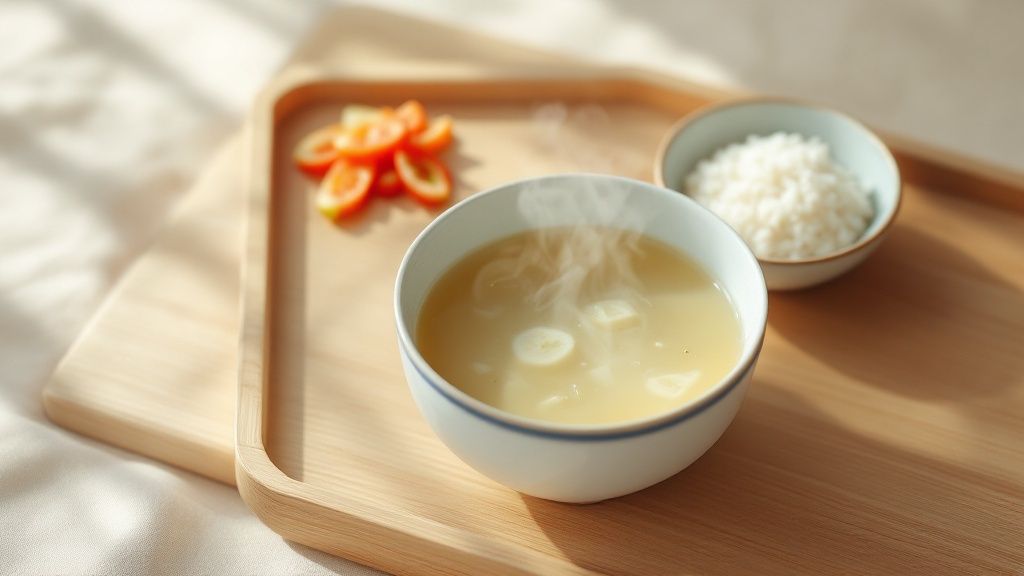
The Japanese diet is known for its weight loss benefits. It combines nutrient-rich foods with mindful eating habits. Let's explore the core components that make this diet so effective.
The Importance of Seasonal Vegetables
The Japanese diet prioritizes seasonal, locally-sourced vegetables. These provide peak flavor and valuable nutrients. Eating seasonally also supports local farmers and ensures a varied intake of vitamins and minerals.
This variety is key for a balanced diet. Think of the difference between winter comfort foods like kabocha squash and refreshing summer cucumbers. Each season brings its own unique nutritional benefits to the table.
Seafood's Role in Weight Management
Seafood is a staple in Japanese cuisine, offering lean protein and omega-3 fatty acids. These fatty acids are known for their anti-inflammatory properties and may benefit fat metabolism.
Fish like salmon and mackerel are excellent sources of vitamin D and iodine. These nutrients are vital for overall health and can play a role in weight regulation.
Fermented Foods and Gut Health
Fermented foods like miso, natto, and tsukemono (pickled vegetables) are common in the Japanese diet. They're packed with probiotics, beneficial bacteria that support a healthy gut.
A balanced gut microbiome is important for digestion, immunity, and may even influence weight. Fermented foods can contribute to overall well-being and possibly aid weight loss. Learn more about Japanese cuisine: How to master...
The Art of Japanese Cooking
Traditional Japanese cooking methods often involve steaming, grilling, or stir-frying. These techniques minimize the need for added fats and oils, keeping meals light and calorie-conscious.
A simple piece of grilled fish with soy sauce and ginger can be incredibly satisfying without extra fats. While the Japanese diet emphasizes whole foods, some individuals may consider supplements. You can find information on the potential role of CBD for weight loss.
Let's take a closer look at the key components of the Japanese diet and how they contribute to a healthy lifestyle.
The following table outlines the main food groups, their nutritional benefits, and how they can support your weight management journey.
Core Components of the Japanese Diet
| Food Category | Examples | Nutritional Benefits | Weight Loss Benefits |
|---|---|---|---|
| Seasonal Vegetables | Daikon radish, Kabocha squash, Cucumbers, Eggplant | Rich in vitamins, minerals, and fiber | Low in calories, high in fiber promotes satiety |
| Seafood | Salmon, Mackerel, Tuna | Lean protein, omega-3 fatty acids, vitamin D, iodine | Supports metabolism, reduces inflammation |
| Fermented Foods | Miso, Natto, Tsukemono | Probiotics for gut health | Improves digestion, may influence weight management |
| Rice | Brown rice, White rice | Carbohydrates for energy, fiber | Provides sustained energy, can be part of a balanced diet |
This table highlights the power of whole, unprocessed foods in the Japanese diet. Each component contributes to both nutritional balance and weight management.
Synergy for Sustainable Weight Loss
These elements work together to create a satisfying and nutritious diet. The focus on whole foods and mindful eating fosters a healthy relationship with food.
This approach supports long-term weight management. It helps individuals achieve their goals without resorting to restrictive diets. This balanced perspective on nutrition and well-being contributes to the Japanese diet's effectiveness.
The Hard Data: Why Japanese Eating Patterns Work
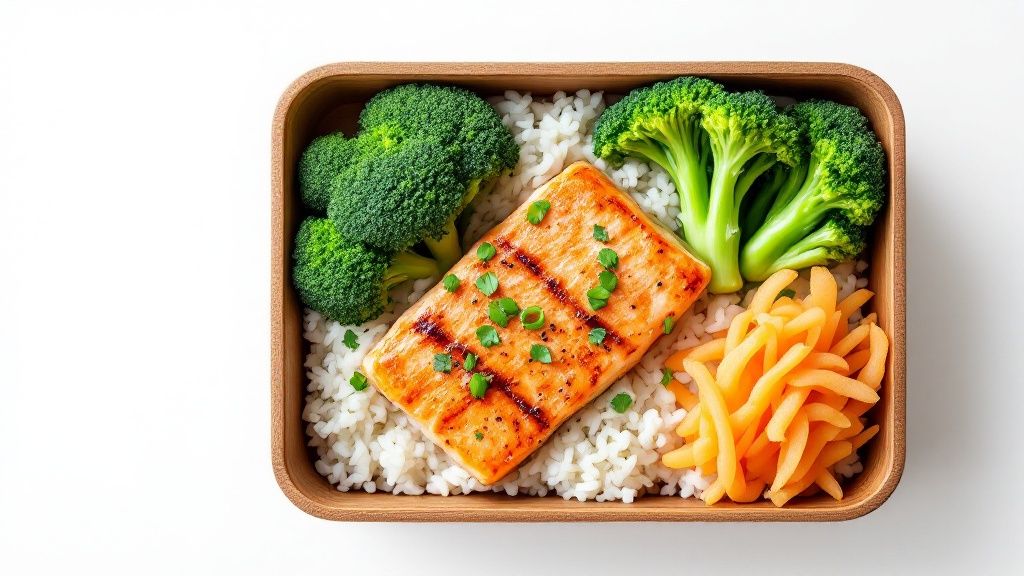
Beyond cultural appreciation, scientific research offers compelling evidence for the effectiveness of the Japanese diet in weight management. This approach, emphasizing whole foods and mindful consumption, demonstrably impacts various health markers.
Impact on Metabolic Rate and Appetite
The Japanese diet, rich in unprocessed foods, can positively influence metabolic rate. The abundance of fiber in vegetables and seaweed, for instance, promotes efficient digestion and helps regulate blood sugar. This stability prevents energy crashes and reduces sugar cravings. The balance of protein and healthy fats from seafood further contributes to feelings of fullness, supporting appetite control.
The Role of Reduced Inflammation
Research indicates the traditional Japanese diet, with its focus on fish, vegetables, and fermented foods, contributes to reduced inflammation. Chronic inflammation can disrupt metabolic processes and contribute to weight gain. By minimizing inflammatory triggers, this dietary approach creates a healthier internal environment for weight management. You might be interested in: How to master.... This benefit extends beyond weight, contributing to overall well-being.
Lower Obesity Rates and Health Outcomes
Japan's obesity prevalence is significantly lower than in many other nations, with 4.3% of adult women and 6.0% of adult men classified as obese. This contrasts sharply with regional averages of 10.3% for women and 7.5% for men. While Japan still faces obesity-related health challenges, particularly type 2 diabetes, studies suggest that even modest weight loss, such as 10% or 15%, can significantly reduce healthcare costs. This is achieved by preventing complications linked to obesity, like type 2 diabetes and hypertension. Find more detailed statistics here: https://globalnutritionreport.org/resources/nutrition-profiles/asia/eastern-asia/japan/. This emphasizes the importance of healthy eating patterns for long-term health and economic benefits. This impact highlights the power of dietary changes in chronic disease prevention and public health improvement.
The Interplay of Diet, Activity, and Genetics
The Japanese approach acknowledges the interconnectedness of diet, physical activity, and genetics in weight management. While genetics do contribute, lifestyle choices remain paramount. Traditional Japanese culture often incorporates regular physical activity into daily routines, supporting healthy weight maintenance. This integrated approach, combined with mindful eating, offers a sustainable path to weight loss and overall well-being.
Your 7-Day Japanese Diet Blueprint for Success
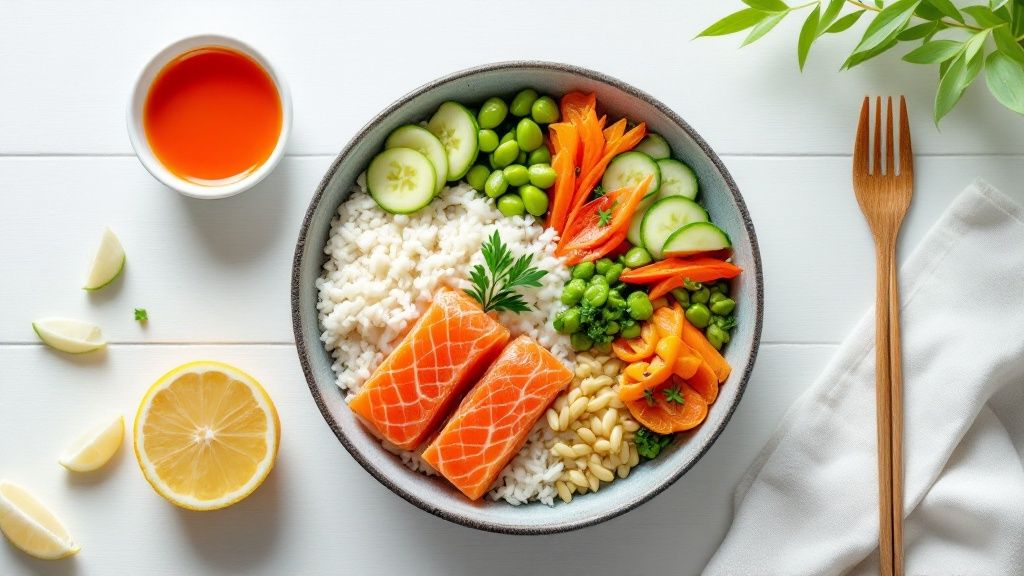
This 7-day Japanese diet plan translates the principles of Japanese eating into actionable meals. It’s designed for sustainable weight loss and introduces a delicious new way to approach food.
Understanding The Plan's Foundation
This plan emphasizes balance, featuring traditional Japanese meals with portion guidance. It focuses on whole, unprocessed foods like fish, vegetables, and rice. This approach promotes satiety while supporting your weight loss goals.
A Week of Japanese-Inspired Meals
The following table outlines a sample 7-day meal plan. It offers a balanced approach to the Japanese diet for weight loss, incorporating various traditional elements. Remember, portion control is key. Aim for meals that leave you feeling satisfied, not overly full, keeping the principle of hara hachi bu in mind.
Here's a glimpse into what a week on this plan might look like:
7-Day Japanese Diet Meal Plan for Weight Loss
| Day | Breakfast | Lunch | Dinner | Snack | Approximate Calories |
|---|---|---|---|---|---|
| 1 | Miso soup, grilled salmon, steamed rice | Vegetable stir-fry with tofu, brown rice | Sashimi salad with mixed greens | Handful of edamame | 1200-1400 |
| 2 | Oatmeal with berries and nuts | Chicken and vegetable skewers, brown rice | Steamed fish with vegetables and rice | Apple slices with almond butter | 1200-1400 |
| 3 | Scrambled eggs with spinach and mushrooms | Salad with grilled chicken or fish | Vegetable and tofu curry with brown rice | Small orange | 1200-1400 |
| 4 | Miso soup, tamagoyaki (rolled omelet) | Sushi rolls (brown rice or no rice) with cucumber and avocado | Chicken or fish teriyaki with steamed vegetables | Rice cakes with avocado | 1200-1400 |
| 5 | Greek yogurt with fruit and granola | Leftover curry | Salmon with roasted vegetables | A pear | 1200-1400 |
| 6 | Smoothie with fruit, spinach, and protein powder | Salad with shrimp or tofu | Udon noodle soup with chicken or tofu and vegetables | Handful of almonds | 1200-1400 |
| 7 | Whole-wheat toast with avocado and egg | Leftover udon soup | Sushi (choose brown rice or no rice options, focus on vegetable and fish fillings) | Small banana | 1200-1400 |
This table provides a balanced intake of around 1200-1400 calories per day. It emphasizes lean protein, healthy fats, and plenty of vegetables.
Ingredient Substitutions and Nutritional Strategy
This plan provides a framework. Feel free to adapt it to your needs.
For example, if you can’t find specific Japanese ingredients, substitute similar items. Bok choy can replace Japanese mustard greens, and brown rice can be used instead of white rice.
Each meal is designed to provide a good balance of protein, complex carbohydrates, and healthy fats. This helps regulate blood sugar and keeps you feeling energized throughout the day. Additionally, the emphasis on vegetables ensures you get plenty of essential vitamins and minerals.
A Sustainable Approach To The Japanese Diet
This 7-day plan is not a crash diet; it's an introduction to a sustainable way of eating. By incorporating these principles into your lifestyle, you can achieve lasting weight loss results and improve your overall health.
The Japanese diet, with its emphasis on fresh, natural foods, is more than just a diet; it's a lifestyle change. This plan offers a practical starting point, helping you experience the benefits of this balanced approach to nutrition. It provides structure and guidance, but remember flexibility is key. Adjust the plan to fit your preferences and dietary needs to create a sustainable eating pattern.
Beyond the Plate: Lifestyle Habits That Amplify Results
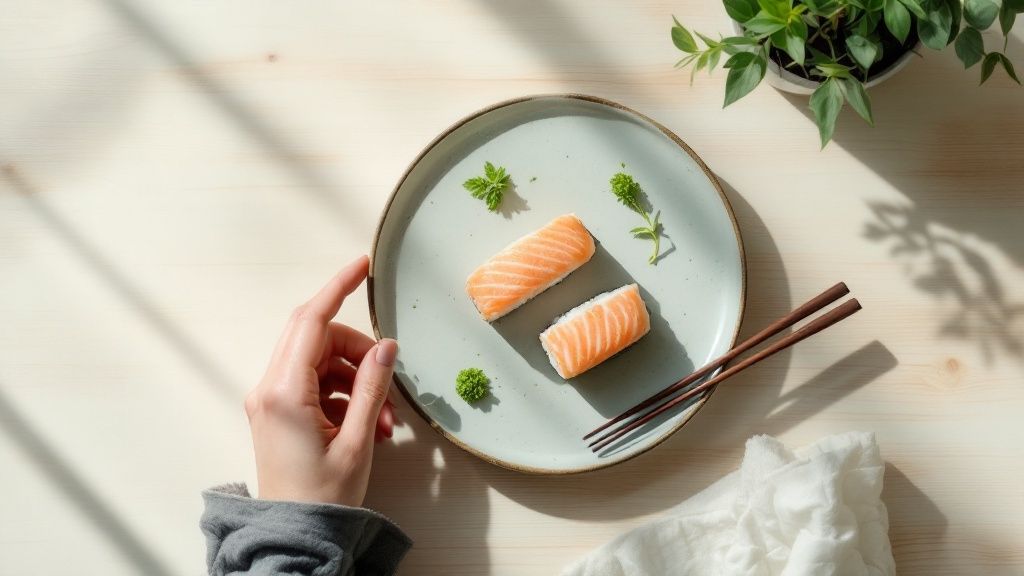
The Japanese diet for weight loss is more than just a list of foods; it's a holistic approach to eating and living. This section explores the lifestyle habits that complement the diet, maximizing its effectiveness and creating sustainable results. These practices enhance the benefits, making weight management feel natural and effortless.
Mindful Eating: Savoring Every Bite
This practice, central to Japanese culture, encourages a deep appreciation for food. It involves slowing down, savoring each bite, and paying attention to your body's hunger cues. This helps prevent overeating by allowing your body to signal fullness. For example, putting your chopsticks down between bites can naturally slow your eating pace.
This allows you to truly appreciate the flavors and textures of your meal. It transforms eating from a rushed activity into a mindful experience.
Integrating Movement Into Daily Life
Regular physical activity is woven into the fabric of Japanese life. This doesn't necessarily mean rigorous gym workouts. Instead, it emphasizes everyday movement like walking, cycling, and gardening.
Many aspects of Japanese culture, such as tea ceremonies and traditional arts, incorporate graceful, deliberate movements. This regular, moderate activity contributes to overall health and supports weight management. You can incorporate similar principles by taking the stairs or walking for short errands.
These small changes can make a significant difference in your daily calorie expenditure. Read also: How to master...
Stress Management: Finding Inner Peace
Chronic stress can disrupt hormonal balance, impacting appetite and potentially leading to weight gain. Japanese culture emphasizes stress reduction techniques like forest bathing (shinrin-yoku), a practice of immersing oneself in nature.
This mindful experience can reduce cortisol levels, the hormone associated with stress. It also promotes relaxation. Other stress management techniques, such as meditation and deep breathing exercises, can further support hormonal balance. They also reduce emotional eating triggers. This focus on inner peace creates a positive feedback loop, supporting both mental and physical well-being.
The Synergy of Lifestyle and Diet
These lifestyle elements enhance the Japanese diet's weight loss benefits. Mindful eating naturally regulates portion control. Regular movement boosts metabolism and calorie burning. Stress management supports hormonal balance and reduces emotional eating.
This combined approach creates a powerful synergy. It makes the Japanese diet for weight loss not just a temporary fix, but a sustainable path to a healthier life. This holistic approach ensures weight management becomes an integrated part of your overall well-being.
By embracing these lifestyle changes alongside the dietary principles, you can achieve lasting weight loss results. You can also enjoy a more fulfilling, balanced life.
Overcoming Challenges: Making the Japanese Diet Work for You
Adopting a new dietary approach like the Japanese diet for weight loss can be challenging. This section addresses these obstacles and offers practical solutions for lasting success, empowering you to make informed choices and build a sustainable plan.
Adapting to Different Needs and Preferences
The Japanese diet, while generally healthy, might need tweaking based on individual dietary needs, cultural contexts, and personal preferences. Vegetarians, for example, can easily swap fish for tofu or tempeh in many dishes. Those with gluten sensitivities can use gluten-free soy sauce or tamari. Adapting recipes and finding substitutes ensures the core principles of the Japanese diet—balance, fresh ingredients, and mindful eating—stay central to your plan.
These adjustments allow you to enjoy the benefits of this dietary approach while respecting your individual needs.
Navigating Social Situations and Restaurant Dining
Social events and restaurant meals can be tricky when changing how you eat. You can, however, navigate these situations while adhering to Japanese dietary principles. When dining out, choose dishes with grilled or steamed protein and lots of vegetables. Don’t hesitate to request modifications, like less sauce or brown rice instead of white.
In social settings, focus on enjoying the company and conversation, and remember the concept of hara hachi bu (eating until you're 80% full). This mindful approach helps maintain balance even in social dining settings.
Managing Sodium and Carbohydrates
Traditional Japanese cuisine can sometimes be high in sodium because of soy sauce and miso. You can manage your sodium intake by using low-sodium versions of these condiments and watching portion sizes. Also, while rice is a staple, switching to brown rice over white rice increases fiber intake and helps regulate blood sugar.
This conscious approach to sodium and carbohydrates lets you enjoy the flavors of Japanese cuisine while supporting your weight loss journey.
Sourcing Authentic Ingredients
Finding authentic Japanese ingredients can be difficult depending on where you live. This is where creativity and flexibility come in. You might find helpful information in this resource: How to master.... Many online retailers specialize in Japanese products, simplifying access to traditional ingredients.
If specific ingredients are unavailable, think about substitutions that align with the core principles of the diet. For example, using locally sourced, seasonal vegetables maintains the essence of Japanese cuisine while supporting local farmers. This adaptability helps you enjoy the diet's benefits wherever you are.
Beyond the diet itself, adopting healthy habits is essential. Consider incorporating mindful eating practices. The impact of the Japanese diet on weight loss is reflected in dietary trends and health outcomes. Increased red meat consumption, a departure from the traditional focus on plant-based foods and seafood, correlates with higher health risks, including obesity. Conversely, sticking to traditional Japanese dietary patterns is associated with longer lifespans and lower risks of diet-related non-communicable diseases. Learn more about this connection here. The emphasis on whole foods, portion control, and mindful eating makes the Japanese diet a strong model for weight loss and overall well-being.
Ready to try authentic Japanese products? Explore a curated collection of high-quality beauty, food, and drink options at Buy Me Japan and experience Japanese excellence. Get a 10% discount on your first order and benefit from flat and free shipping options.
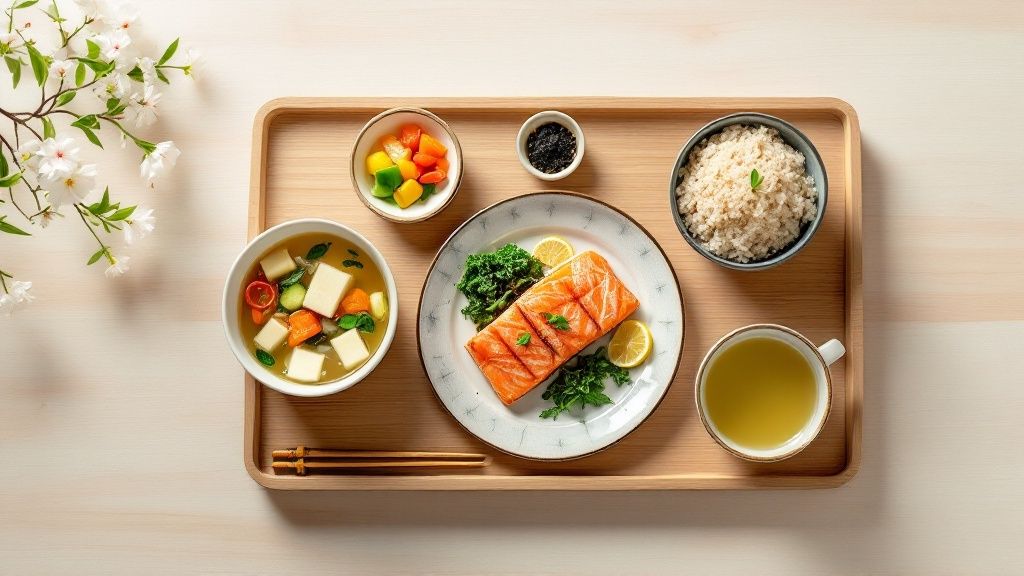



Share:
Top 7 Best Japanese Matcha Brands for 2025
Green Tea Skincare Benefits: Unlock Radiant, Healthy Skin